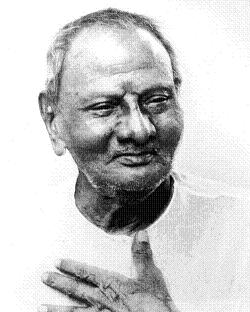Where Do We Take Our Instructions?
We tend as a society to remove from sight those realities that may disturb our sense of order, of control, of comfort, of civilised pleasantness. It is very tempting to arrange things so that one lives a predictable and well-cushioned life shielded from the human wreckage that lies just below the surface. Yet something as simple as spending an hour or two in a railway carriage outside of peak hour can reveal how wafer-thin the veneer of social order and civility can be. And the surprising number of young people begging for food and money in and around the streets of central Melbourne reveals further what lies behind the façade of affluence and self-satisfaction that is everywhere projected. One does not need to walk the streets of Calcutta to know the faces of the dispossessed and the privation and deep need that everywhere burdens the life of so many.
Mother Teresa of Calcutta was born of a peasant family in Albania in 1910. Her father died when she was a young child and she was raised in the simple faith of her community. She joined the Loreto Sisters at the age of 18, having already decided when she was 12 years old that she would one day serve as a missionary in India. After a short stay in Ireland, she arrived in north India in 1929. Over the next 20 years, she formalised her religious vows and served as a teacher in a Loreto convent school for girls in Calcutta.
In 1948 after experiencing a profoundly transformative personal revelation, she departed the convent, replaced her regular Loreto habit with a plain blue-lined cotton sari, and immersed herself in the street life of Calcutta. After securing modest accommodation, she immediately started a small school for girls and began visiting the destitute and the dying who were everywhere to be found in the city. Her work was sanctioned by Rome in 1952 and the small group of women that had formed around her took on the name "Missionaries of Charity."
The Gospel of Thomas
The Nag Hammadi Library
Translated by Stephen Patterson and Marvin Meyer
 |
Introduction
The Gnostic Society Library
There is a growing consensus among scholars that the Gospel of Thomas – discovered over a half century ago in the Egyptian desert – dates to the very beginnings of the Christian era and may well have taken first form before any of the four traditional canonical Gospels. During the first few decades after its discovery several voices representing established orthodox biases argued that the Gospel of Thomas (abbreviated, GTh) was a late-second or third century Gnostic forgery. Scholars currently involved in Thomas studies now largely reject that view, though such arguments will still be heard from orthodox apologists and are encountered in some of the earlier publications about Thomas.
Today most students would agree that the Gospel of Thomas has opened a new perspective on the first voice of the Christian tradition. Recent studies centered on GTh have led to a stark reappraisal of the forces and events forming "orthodoxy" during the second and third centuries. But more importantly, the Gospel of Thomas is awakening interest in a forgotten spiritual legacy of Christian culture. The incipit (or "beginning words") of Thomas invite each of us "who has ears to hear" to join in a unique quest:
These are the hidden words that the living Jesus spoke, and that Didymos Judas Thomas wrote down. And He said: "Whoever finds the meaning of these words will not taste death."
The Sacrament of the Present Moment
Mark Mallet

As I have written here frequently, I believe that Heaven’s treasuries are wide-open. That God is pouring tremendous graces upon whomever will ask for them in these days of change.
The question then, is how to receive these graces. While God may pour them out in very miraculous or supernatural ways, such as in the Sacraments, I believe they are constantly available to us through the ordinary course of our daily lives. To be more precise, they are to be found in the present moment.
AN UNFORGETTABLE NEW YEAR’S EVE
I define the present moment as "the only point where reality exists." I say this because too many of us spend most of our time living in the past, which no longer exists; or we live in the future, which hasn’t happened yet. To live in the future or the past, is to live in an illusion. To build a house on sand is unwise; building our lives on illusions is no more stable.
At a New Year’s Eve celebration, my wife and I were sitting at a table with friends, laughing and enjoying the celebrations, when suddenly a man at the table across from us slumped off his chair onto the floor. Gone—just like that. Thirty minutes later, the guy who attempted CPR on the deceased, was now lifting a child into the air to pop balloons hanging over the dance floor. The contrast—the frailty of life—was startling.
Any one of us could die in the next second. That’s why it is senseless to be anxious about anything. -Anything.
Remembering Nisargadatta Maharaj
David Godman
A conversation with Harriet
 |
Nisargadatta Maharaj
Sri Nisargadatta Maharaj I.
01 -Sri Nisargadatta Maharaj - Awaken to the Eternal
05 -Sri Nisargadatta Maharaj - Awaken to the Eternal
06 -Sri Nisargadatta Maharaj - Awaken to the Eternal
I was sitting with a visitor recently, looking at a new book on Nisargadatta Maharaj that consisted of photos and brief quotes. I knew some of the people in the pictures and narrated a few stories about them. This prompted a wider and lengthy discussion on some of the events that went on in Maharaj's presence. After she left I felt prompted to write down some of the things I had remembered since I had never bothered to record any of my memories of Maharaj before. As I went about recording the conversation, a few other memories surfaced, things I hadn't thought about for years. This, therefore, is a record of a pleasant afternoon's talk, supplemented by recollections of related incidents that somehow never came up.
Harriet: Every book I have seen about Maharaj, and I think I have looked at most of them, is a record of his teachings. Did no one ever bother to record the things that were going on around him? Ramakrishna had The Gospel of Ramakrishna, Ramana Maharshi had Day by Day, and a whole library of books by devotees that all talk about life with their Guru. Why hasn't Maharaj spawned a similar genre?
David: Maharaj very rarely spoke about his life, and he didn't encourage questions about it. I think he saw himself as a kind of doctor who diagnosed and treated the perceived spiritual ailments of the people who came to him for advice. His medicine was his presence and his powerful words. Anecdotes from his past were not part of the prescription. Nor did he seem interested in telling stories about anything or anyone else.
Harriet: You said 'rarely spoke'. That means that you must have heard at least a few stories. What did you hear him talk about?
David: Mostly about his Guru, Siddharameshwar Maharaj, and the effect he had had on his life. I think his love for his Guru and his gratitude to him were always present with him. Nisargadatta Maharaj used to do five bhajans a day simply because his Guru had asked him to. Siddharameshwar Maharaj had passed away in 1936, but Nisargadatta Maharaj was still continuing with these practices more than forty years later.
Personal or Impersonal?
Tony Parsons
Welcome to The Open Secret
The titles non-dual and Advaita attempt to describe the principle of wholeness, unicity or that which is already at one.
A unified reality in which there are "not two" or there is "no other" surely confirms the illusory nature of separation. If separation is illusory, then any attempt to not be separate is rooted in a dualistic perspective. So the basic principle of any teaching which attempts to transform an illusory state of being separate into a state of at-oneness is based on the belief in a divided reality and cannot therefore claim to be non-dual.
During the last decade there seems to have been a growing interest in what is known as “Advaita” or “non-dual” communication about enlightenment. The recent “Conscious TV” interviews and the beautifully crafted dvd “Who’s Driving the Dreambus” represent a fair cross-section of people of so-called “non-dual” persuasion but whose perceptions seem to vary considerably.
There are millions of books published on the same subject with wildly differing views. These days the term “non-dual” is being used for all kinds of seeking activities. You can go to non-dual conferences or indulge in a “12-month course on non-dual enlightenment”. Non-dual therapy is available, and there is even an on-line “non-dual” speak club which “no-one” can join!
For anyone interested or newly investigating this subject, it can all be very confusing.
The Lotus Sutra
Translated by Burton Watson
Chapter Twenty-five: The Universal Gate of Bodhisattva Kanzeon
At that time the bodhisattva Inexhaustible Intent immediately rose from his seat, bared his right shoulder, pressed his palms together and, facing the Buddha, spoke these words: "World Honored One, this Bodhisattva Perceiver of the World's Sounds-- why is he called Perceiver of the World's Sounds?"
The Buddha said to Bodhisattva Inexhaustible Intent: "Good man, suppose there are immeasurable hundreds, thousands, ten thousands, millions of living beings who are undergoing various trials and suffering. If they hear of this Bodhisattva Perceiver of the World's Sounds and single-mindedly call his name, then at once he will perceive the sound of their voices and they will all gain deliverance from their trials.
If someone, holding fast to the name of bodhisattva perceiver of the world's sounds, should enter a great fire, the fire could not burn him. This would come about because of this bodhisattva's authority and supernatural power. If one were washed away by a great flood and call upon his name, one would immediately find himself in a shallow place.
"Suppose there were a hundred, a thousand, ten thousand, a million living beings who, seeking for gold, silver, lapis lazuli, seashell, agate, coral, amber, pearls, and other treasures, set out on the great sea. and suppose a fierce wind should blow their ship off course and it drifted to the land of raksasas demons. If among those people there is even just one who calls the name of Bodhisattva Perceiver of the World's sounds, then all those people will be delivered from their troubles with the raksasas. This is why he is called Perceiver of the World's Sounds.
THE UNKNOWN LIFE OF JESUS CHRIST
Nicolas Notovitch
Translated by J. H. Connelly and L. Landsberg
Project Gutenberg, The Unknown Life of Jesus Christ by Nicolas Notovitch
One day, while visiting a Buddhist convent on my route, I learned from a chief lama, that there existed in the archives of Lhassa, very ancient memoirs relating to the life of Jesus Christ and the occidental nations, and that certain great monasteries possessed old copies and translations of those chronicles.
Preface
After the Turkish War (1877-1878) I made a series of travels in the Orient. From the little remarkable Balkan peninsula, I went across the Caucasus to Central Asia and Persia, and finally, in 1887, visited India, an admirable country which had attracted me from my earliest childhood.
My purpose in this journey was to study and know, at home, the peoples who inhabit India and their customs, the grand and mysterious archæology, and the colossal and majestic nature of their country. Wandering about without fixed plans, from one place to another, I came to mountainous Afghanistan, whence I regained India by way of the picturesque passes of Bolan and Guernaï. Then, going up the Indus to Raval Pindi, I ran over the Pendjab--the land of the five rivers; visited the Golden Temple of Amritsa--the tomb of the King of Pendjab, Randjid Singh, near Lahore; and turned toward Kachmyr, "The Valley of Eternal Bliss." Thence I directed my peregrinations as my curiosity impelled me, until I arrived in Ladak, whence I intended returning to Russia by way of Karakoroum and Chinese Turkestan.
Love and Strife: Don't Spill A Drop
 |
Listen now to a further point: no mortal thing
Has a beginning, nor does it end in death and obliteration;
There is only a mixing and then a separating of what was mixed,
But by mortal men these processes are named 'beginnings.'
~ Empedocles
***
"Dream delivers us to dream, and there is no end to illusion. Life is a train of moods like a string of beads, and as we pass through them they prove to be many-coloured lenses which paint the world their own hue, and each shows only what lies in its focus."
~ R.W. Emerson
***
Zen teachings of Master Lin-Chi
Master Lin Chi
(Died 867)
Those of you who wish to discipline themselves in the Buddha's Dharma must seek true understanding. When this understanding is attained you will not be defiled by birth and death. Whether walking or standing still, you will be your own master. Even when you are not trying to achieve something extraordinary, it will come to you all by itself.
O Followers of the Way, from olden times each of my predecessors had his own way of training his disciples. As to my way of leading people: all that they need is not to be deluded by others. (Be independent) and go on your way whenever you desire: have no hesitancy.
Do you know where the disease lies which keeps you learners from reaching (true understanding? It lies where you have no faith in your Self. When faith in your Self is lacking you find yourself hurried by others in every possible way. At every encounter you are no longer your master: you are driven about by others this way or that.
All that is required is all at once to cease leaving your Self in search of something external. When this is done you will find your Self no different from the Buddha or the patriarch. Do you want to know who the Buddha or patriarch is? He is no other than the one who is, at this moment, right in front of me, listening to my talk on the Dharma. You have no faith in him and therefore you are in quest of someone else somewhere outside. And what will you find? Nothing but words and names, however excellent. You will never reach the moving spirit in the Buddha or patriarch.
Heart of Perfect Wisdom
Unknown
Rochester Zen Center
[From WikiPedia:] The Heart of Perfect Wisdom Sutra or Heart Sutra or Essence of Wisdom Sutra (Sanskrit: प्रज्ञापारमिताहृदय Prajñāpāramitā Hṛdaya; Chinese: 摩訶般若波羅蜜多心經) (the word sutra is not present in known Sanskrit manuscripts) is a well-known Mahāyāna Buddhist sutra that is very popular among Mahayana Buddhists both for its brevity and depth of meaning. Buddhist writer and translator Bill Porter calls the Heart Sutra the best known and most popular of all Buddhist scriptures.
The Heart Sutra is a member of the Perfection of Wisdom (Prajñāpāramitā) class of Mahāyāna Buddhist literature, and along with the Diamond Sutra, is perhaps the most prominent representative of the genre.
The Heart Sutra is made up of 14 shlokas in Sanskrit; a shloka composed of 32 syllables. In Chinese, it is 260 Chinese characters, while in English it is composed of sixteen sentences. This makes it one of the most highly abbreviated versions of the Perfection of Wisdom texts, which exist in various lengths up to 100,000 shlokas. According to Buddhist scholar and author Geshe Kelsang Gyatso in his commentary to the Heart Sutra:
The Essence of Wisdom Sutra (Heart Sutra) is much shorter than the other Perfection of Wisdom Sutras but it contains explicitly or implicitly the entire meaning of the longer Sutras.
This sutra is classified by Edward Conze as belonging to the third of four periods in the development of the Perfection of Wisdom canon, although because it contains a mantra (sometimes called a dharani), it does overlap with the final tantric phase of development according to this scheme, and is included in the tantra section of at least some editions of the Kangyur. Conze estimates the sutra's date of origin to be 350 CE; some others consider it to be two centuries older than that. Recent scholarship is unable to verify any date earlier than the 7th century CE.
The Chinese version is frequently chanted (in the local pronunciation) by the Chan (Zen/Seon/Thiền) sects during ceremonies in China, Japan, Korea, and Vietnam respectively. It is also significant to the Shingon Buddhist school in Japan, whose founder Kūkai wrote a commentary on it, and to the various Tibetan Buddhist schools, where it is studied extensively.
The sutra is in a small class of sutras not attributed to the Buddha. In some versions of the text, starting with that of Fayue dating to about 735, the Buddha confirms and praises the words of Avalokiteśvara, although this is not included in the preeminent Chinese version translated by Xuanzang. The Tibetan canon uses the longer version, although Tibetan translations without the framing text have been found at Dunhuang. The Chinese Buddhist canon includes both long and short versions, and both versions exist in Sanskrit.







